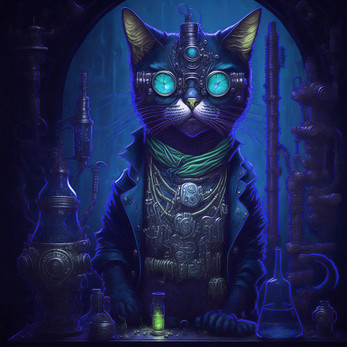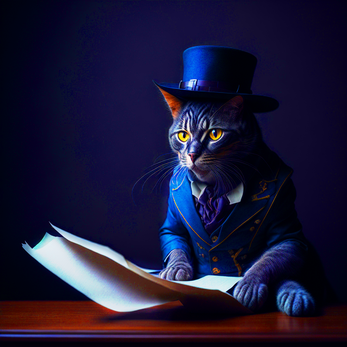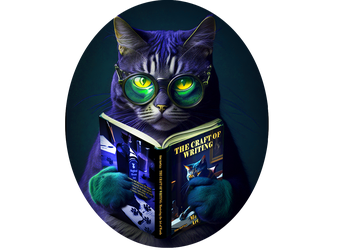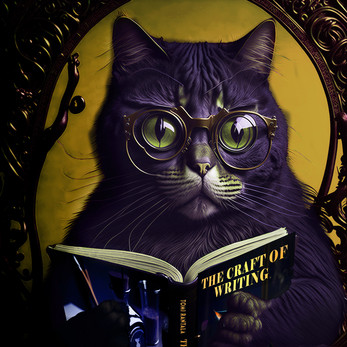Demo: The Craft of Writing: Mastering the Art of Words (free demo)
A downloadable book
This is a free demo of 100 pages of the book. Full book available on: https://bit.ly/writinghelping (itch.io PDF)
and all amazons around globe: https://amzn.to/3LWrEw8 (amazon.com)
Embark on an incredible journey and discover the magic of storytelling with this guide to writing your own novel. From the depths of your imagination to the pages of your book, you'll create new worlds, meet captivating characters, and find your own unique writing voice. With expert guidance from seasoned writers, you'll learn how to weave together plot, character, and setting into a tapestry of pure enchantment that will leave readers spellbound. Let your creativity soar as you build intricate and fascinating worlds, fill them with memorable characters, and craft stories that will captivate readers around the globe. As you delve deeper into the art of writing, you'll discover the thrill of bringing your own vision to life and the satisfaction of sharing your stories with the world. Unleash your imagination and embark on an adventure of a lifetime – with this guide as your trusty companion, your writing dreams are within reach. Physical copy on all amazons. https://www.amazon.com/dp/B0C47WDZJV?ref_=pe_3052080_397514860
- Table of Contents
- The Journey Begins 14
- Introduction to Storytelling 18
- What is Storytelling? 18
- The Key Elements of Storytelling 19
- Crafting Your Story 19
- Conclusion 20
- Finding Inspiration for Your Story 21
- Mining Your Own Life 21
- Observing the World Around You 21
- Researching Other Stories 22
- Exercises to Spark Your Creativity 22
- Tips for Keeping Inspiration Flowing 23
- Summary 24
- Developing Your Story Idea 25
- Characters 25
- Plot 25
- Setting 26
- Tone and Theme 26
- Exercises to Develop Your Story Idea 27
- Tips for Developing Your Story Idea 27
- Summary 28
- Characters 29
- Developing a Character Profile 30
- Avoiding Stereotypes 31
- Creating Character Arcs 31
- The Importance of Creating Memorable Characters 32
- Creating Backstories 33
- Personality Traits and Flaws 33
- Motivations and Conflicts 34
- Protagonists and Antagonists 34
- Writing Dialogue 36
- Summary 36
- A great list of motivations and goals for your characters 37
- Crafting a Strong Opening 47
- Engaging the Reader 47
- Establishing the Setting 47
- Introducing the Protagonist 48
- Establishing the Conflict 48
- Tips for Crafting a Strong Opening 48
- Summary 49
- Beginning, Middle and Ending 50
- Beginning: Capture the Reader 50
- Summary: 51
- The Middle: Keeping the Momentum Going 51
- Summary: 53
- Crafting the Ending of Your Book 53
- Developing Compelling Characters 54
- Developing a Character Profile 54
- Creating Character Arcs 55
- Writing Dialogue 55
- Defining Your Characters' Motivations 56
- Creating Three-Dimensional Characters 57
- Showing, Not Telling 57
- Understanding Your Characters' Motivations 58
- Creating Backstories 58
- Giving Your Characters Flaws 58
- Allowing Your Characters to Change and Grow 59
- Creating Unique Voices 59
- Main-Character(s) vs. Opponent(s) 59
- Summary 61
- Creating Conflict: The Importance of Antagonists in Your Story 62
- The Antagonist´s list of traps and obstacles (and how protagonist can possibly solve them) 64
- List of tips and principles for helping protagonists escape the traps and obstacles set by their antagonists: 65
- Antagonist´s weaknesses and how protagonist can use it for her/his benefit 67
- Betrayal 67
- Overconfidence 68
- Greed 68
- Hubris 68
- Fear 69
- Love and Lust 70
- Temptation 71
- Ignorance 71
- Revenge 72
- Impulsiveness 73
- Arrogance 73
- Envy 73
- Naivety 73
- Impatience 74
- Cowardice 74
- Addiction 74
- Trust 74
- And Many More Antagonist Weaknesses To Use Against Them 75
- Examples of surprise weaknesses and surprise endings. 78
- Building a Cohesive Cast: The Importance of Character Relationships in Storytelling 81
- Tips: 82
- Summary: 83
- Crafting Dialogue that Rings True 84
- Finding Your Characters' Voices 84
- Using Dialogue to Reveal Character 84
- Writing Dialogue That Advances the Plot 85
- Using Contractions 86
- Avoiding Info-Dumps 86
- Using Speech Patterns 86
- Reading Dialogue Aloud 87
- Keeping Dialogue Action-Based 87
- Summary 87
- Building a Believable World 88
- Establishing the Rules of Your World 88
- Creating Detailed Descriptions 88
- Making the World Consistent 89
- Summary 89
- Crafting Compelling Settings 91
- Using Sensory Details 91
- Creating a Sense of Place 91
- Using Symbolism 91
- Creating a Sense of Time 92
- Balancing Description with Action 92
- Summary 92
- Using Foreshadowing and Symbolism: Creating Depth and Meaning 93
- Establishing Themes 93
- Using Symbolism 93
- Using Foreshadowing 93
- Balancing Clarity with Subtlety 93
- Using Multiple Layers 94
- Summary 94
- 10 examples of how a writer can use symbolism in their writing: 95
- A great list of symbols and their meanings 97
- The Importance of Themes: Creating a Message 100
- Identify the Central Idea 100
- Build the Story Around the Theme 100
- Use Symbolism and Imagery 100
- Explore Contrasting Ideas 101
- Create a Narrative Arc 101
- Summary 101
- 100 common themes found in fictional books: 102
- Understanding Point of View: Choosing the Right Perspective 105
- First Person Perspective 105
- Benefits of First Person Perspective: 105
- Limitations of First Person Perspective: 105
- Third-person perspective 106
- Benefits of Third Person Perspective: 109
- Limitations of Third Person Perspective: 109
- Using Multiple Perspectives 109
- Other Possible Perspectives 110
- Conclusion 110
- Examples of each perspective using the same character, theme, and setting: 110
- Summary: 111
- Exploring Different Verb Tenses in Writing 112
- Examples in different tenses: 113
- Plot and twists 116
- Plot Devices: How to Use Them 125
- Example: Hitchcock's Plot Device and MacGuffin 126
- Summary: 127
- The Missing Heir – an example of plotting 128
- Beginning: 128
- Middle: 129
- Twist: 129
- Ending: 130
- Plot Outline Table: 130
- Other plotting examples – Victorian Horror Love Story 131
- Androids in The Cyberpunk City 132
- Cliffhanger and Open Ending 133
- Ideas for Cliffhanger Endings 136
- Open Ending 138
- Consider Your Genre and Tone 140
- Bring Closure to the Story Arcs 140
- Deliver a Memorable Conclusion 140
- Avoid Over-explaining 141
- Create Emotional Resonance 141
- Summary: 141
- Story Arc and The five-act structure 142
- The five-act structure 143
- The three-act structure chart 146
- Writing a Romance Novel 147
- Writing a Whodunit: Tips and Techniques 149
- How to Write a Horror Story 151
- Setting the Atmosphere 151
- Characters 151
- Plot and Twists 152
- Tension and Suspense 152
- Conclusion 152
- Writing a Sci-Fi and Cyberpunk Story 154
- Writing Historical Fiction 156
- Research, Research, Research 156
- Create Compelling Characters 156
- Use Authentic Language 157
- Set the Scene 157
- Weave Real Events into Your Story 157
- End on a High Note 157
- Summary: 158
- Writing a Compelling Crime Story 159
- Summary: 160
- Writing a Fantasy Novel 161
- How to Write a Comedy 163
- Summary: 164
- 50 tips and tricks for writers: 165
- Different Ways of Writing 169
- Innovative Methods of Writing a Novel 171
- Things NOT to Write: Common Writing Errors to Avoid 177
- Elements of a Novel: Dialogue and Other Essential Parts 179
- Dialogue: 179
- Other Essential Parts: 179
- Writing Techniques to Elevate Your Storytelling 181
- Example: 182
- The Power of Words in Writing 184
- Summary: 185
- Foreshadowing and Flashbacks 187
- Dos: 188
- Don'ts: 189
- Character-driven, plot planning and other styles 190
- Character-Driven Writing Style 190
- Why is Character-Driven Writing Important? 191
- How to Develop Fully Realized Characters 191
- Plot Planning 193
- Plot Planning Chart 194
- Character-Driven Writing vs. Plot-Driven Writing 195
- Conclusion 195
- Other Styles 195
- Exploring Magical Realism and Other Unique Writing Styles 196
- Magical Realism 196
- Plotless 197
- Other Unique Writing Styles 198
- Historical And Modern Styles – Finding Your Voice 200
- New writer – You 202
- The Importance of Trying New Styles 203
- Choosing the Right Style 203
- Conclusion 204
- Tips and tricks: 204
- The Art of Writing Style: Crafting Words that Speak Volumes 205
- Examples of writing styles: 206
- Conclusion 212
- The Writer's Workroom: Creating the Perfect Writing Space 213
- Introduction: 213
- The Importance of Creating a Dedicated Writing Space 213
- Designing Your Ideal Writing Space 214
- Choosing the Right Tools and Equipment 216
- Creating a Writing Schedule 217
- Writer's Block and How to Overcome It (Or Not) 220
- Final Words: The Joy of Writing and Sharing Your Gift 223
- You (and Your Books to be written by you) 225
| Status | Released |
| Category | Book |
| Author | acrofobiclunchbreak |
| Genre | Visual Novel |
| Tags | Art Book, writing, writing-guide |
Download
Click download now to get access to the following files:











